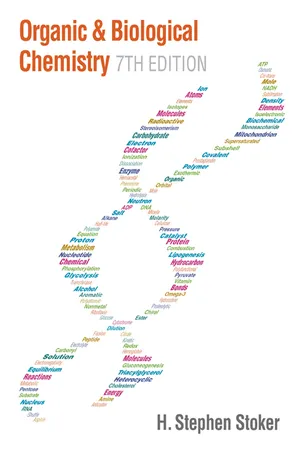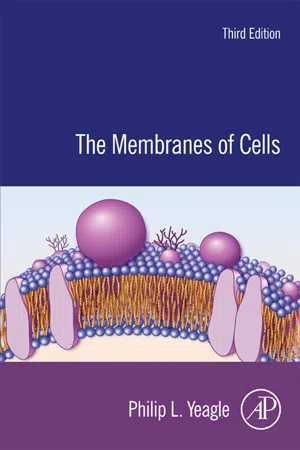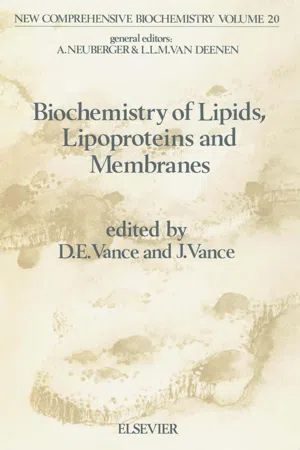Chemistry
Cholesterol
Cholesterol is a type of lipid molecule found in the cell membranes of all animal tissues. It plays a crucial role in maintaining cell membrane structure and function. Cholesterol is also a precursor for the synthesis of steroid hormones, bile acids, and vitamin D in the body.
Written by Perlego with AI-assistance
Related key terms
1 of 5
11 Key excerpts on "Cholesterol"
- eBook - PDF
- H. Stephen Stoker(Author)
- 2015(Publication Date)
- Cengage Learning EMEA(Publisher)
Cholesterol’s structure differs markedly from that of other membrane lipids in that (1) there are no fatty acid residues present and (2) nei-ther glycerol nor sphingosine is present as the platform molecule. Cholesterol is a steroid. A steroid is a lipid whose structure is based on a fused-ring system that involves three 6-membered rings and one 5-membered ring. This steroid fused-ring system, which is called the steroid nucleus, has the following structure: Steroid nucleus A B C D 1 2 3 4 5 6 7 8 9 10 11 12 13 14 15 16 17 Note that each of the rings of the steroid nucleus carries a letter designation and that a “consecutive” numbering system is used to denote individual carbon atoms. Numerous steroids have been isolated from plants, animals, and human beings. Location of double bonds within the fused-ring system and the nature and loca-tion of substituents distinguish one steroid from another. Most steroids have an oxygen-containing functional group ( O or ! OH) at carbon 3 and some kind of side chain at carbon 17. Many also have a double bond from carbon 5 to either carbon 4 or carbon 6. Cholesterol is a C 27 steroid molecule that is a component of cell membranes and a precursor for other steroid-based lipids. It is the most abundant steroid in the human body. ◀ The -ol ending in the name cholester ol conveys the information that an alco-hol functional group is present in this molecule; it is located on carbon 3 of the ster-oid nucleus. In addition, Cholesterol has methyl group attachments at carbons 10 and 13, a carbon–carbon double bond between carbons 5 and 6, and an eight-carbon ▶ Besides being an important molecule in and of itself, cho-lesterol serves as a precursor for several other important steroid molecules including bile acids (Section 8-11), steroid hormones (Section 8-12), and vitamin D (Section 10-13). Copyright 2016 Cengage Learning. All Rights Reserved. May not be copied, scanned, or duplicated, in whole or in part. - eBook - ePub
- Philip L. Yeagle(Author)
- 2016(Publication Date)
- Academic Press(Publisher)
There is a dark side to the Cholesterol story, however. Cholesterol plays a role that is lethal to mammals, particularly to humans. High levels of serum Cholesterol, particularly in the form of circulating low-density lipoproteins, can lead to the development of atherosclerotic plaques on arterial walls. When these plaques occlude coronary arteries that feed heart muscle, some heart muscle dies as a consequence. The myocardial infarct, or heart attack, that results can kill.In this chapter, the focus will be on understanding the essential role of Cholesterol in Cholesterol-requiring cells, with limited treatment of the sterols of nonmammalian cells for comparison (more research is available on Cholesterol in mammalian cells than on other sterols in nonmammalian sterol-requiring cells). The available knowledge on Cholesterol in mammalian cell membranes will be summarized and then a discussion will follow on a current hypothesis for the essential role of Cholesterol in Cholesterol-requiring cells (as well as the essential role of other sterols in other organisms, such as ergosterol in yeast). Much of the material in this chapter has appeared in other forms.1 ,29.1 Structure and Properties of the Cholesterol Molecule
The chemical structure of Cholesterol appears in Fig. 9.1 . The chemical structures of related sterols appear in Fig. 2.13 . Models of four common sterols appear in Fig. 9.2 for comparison. The chemical structure of Cholesterol is built around four fused carbon rings, referred to as the A, B, C, and D rings (moving away from the hydroxyl). Rings A, B, and C are made of six carbons and ring D is made of five carbons. This fused ring system is predominantly planar (though the A ring can adopt an alternate conformation).3 - eBook - PDF
Animal Clinical Chemistry
A Practical Handbook for Toxicologists and Biomedical Researchers, Second Edition
- G.O. Evans(Author)
- 2009(Publication Date)
- CRC Press(Publisher)
183 9 Lipids 9.1 BIOCHEMISTRY AND PHYSIOLOGY The collective term lipids is used to describe molecules that have diverse chemical and functional relationships; they all have poor solubility in water but are soluble in organic solvents. They can be broadly divided into sterols, including choles-terol, fatty acids, or molecules containing fatty acids—for example, triglycerides and phospholipids, the fat-soluble vitamins, eicosanoids, and sphingolipids. A more recent comprehensive classification of lipids proposes that they are divided into eight categories: fatty acyls, glycerolipids, glycerophospholipids, sphingolipids, ste-rol lipids, prenol lipids, saccharolipids, and polyketides, based on the hydrophobic and hydrophilic properties of the lipids (Fahy et al. 2005). This classification should prove useful as the analytical approaches using liquid chromatography and mass spectrometry provide more information on lipids and their interactions in the field of lipidomics (Wenk 2005). Cholesterol is the major sterol in the body and occurs mainly as the nonesterified free form, which is a fundamental component of cell membranes and the precursor for steroid hormones and bile acids. Cholesteryl esters present in the tissues and plasma are mainly formed by Cholesterol esterification with long chain fatty acids; these Cholesterol esters act as a storage pool. Most of the requirements for Cholesterol are met by endogenous synthesis, mainly in the liver, with the exogenous supplemen-tation from the diet. Fatty acids have a basic structure, R-COOH, and the important fatty acids have long chains with an even number of carbon atoms (C12–C20), which may be described as saturated (e.g., stearic acid, C18:1), monounsaturated (e.g., oleic acid, C18:2), and polysaturated (e.g., linoleic, C18:2, and linolenic, C18:3, acids). - eBook - PDF
Food Lipids
Chemistry, Nutrition and Biotechnology
- Sara Diana Garduno Diaz(Author)
- 2019(Publication Date)
- Delve Publishing(Publisher)
Cholesterol is the major component of myelin and renders the myelin sheath impermeable to electron transfer (dielectric) in the brain and other nervous tissues. In plant tissues phytosterol and campesterol are the major sterols. The plant sterols and their stanol derivatives (saturated at the 5–6 carbons), along with cholestenol, are active in regulating Cholesterol absorption. All these sterols are consumed in the diet, and some are being added to foods as positive aides to regulation of Cholesterol metabolism. Sterols may be found either as free sterols, acylated (sterol esters), alkylated (steryl alkyl ethers), sulfated (sterol sulfate), or linked to a glycoside moiety (steryl glycosides) which can be itself acylated (acylated sterol glycosides). The links between dietary Cholesterol and cardiovascular disease are highly controversial. While epidemiological studies and clinical interventions have shown the lack of correlation between Cholesterol intake and cardiovascular disease (CVD) risk, there is still concern among health practitioners and the general population regarding dietary Cholesterol. Food Lipids: Chemistry, Nutrition and Biotechnology 42 Box 2.7. Cholesterol Cholesterol is a sterol (a combination steroid and alcohol) and a lipid found in the cell membranes of all body tissues. It is transported in the blood plasma of all animals. The name originates from the Greek chole- (bile) and stereos (solid), and the chemi-cal suffix -ol for an alcohol, as researchers first identified Cholesterol (C27H45OH) in solid form in gallstones in 1784. Cholesterol is transported throughout the body via lipoprotein particles. The largest lipoproteins, which primarily transport fats from the intestinal mucosa to the liver, are called chylomicrons. They carry mostly triglyceride fats and Cholesterol (that are from food and especially internal choles-terol secreted by the liver into the bile). - eBook - PDF
- Khetarpaul, Neelam(Authors)
- 2021(Publication Date)
- Daya Publishing House(Publisher)
Chapter 7 Role of Cholesterol in Human Health Cholesterol an unusual waxy and fat-like substance is essential to life. It is a sterol (a combination of steroid and alcohol) and lipid (a type of fat). It’s found in foods such as eggs and dairy products and is also manufactured in the body, especially the liver. It is essential for many of the body’s metabolic processes. It helps make hormones like oestrogen, testosterone and adrenaline (the name originates from the Greek ‘chole’ meaning bile and stereos meaning solid). Role of Cholesterol Cholesterol helps to lubricate the skin and hair, keeping them from drying out. It helps in the digestion of food fats. Our digestive system relies heavily on bile salts to help emulsify and digest fats. The liver makes about a quart of these a day (just under a liter) with Cholesterol as a major ingredient, storing a concentrated version in the gall bladder for controlled release as foods (especially fatty ones) enter the small intestine. It’s present in all of our cell walls, providing watertight integrity This ebook is exclusively for this university only. Cannot be resold/distributed. and structural support, and is especially essential to electrically conductive nerve and brain cells- we can’t have moisture and wayward ions seeping in and short-circuiting things. This might explain why the nervous system is such a large repository of Cholesterol, and why a diet that includes adequate amounts of it is a must for infants and small children with growing brains. Luckily, both human and bovine (cow’s) milk contain plenty of it for just this purpose. Mood and behaviour are also apparently linked to proper blood Cholesterol levels. Studies have shown a decrease in the number of serotonin receptors as Cholesterol levels lower. Serotonin is a key neurotransmitter which figures heavily in depression, among other things. - eBook - PDF
Cholesterol
Chemistry, Biochemistry, and Pathology
- Robert P. Cook(Author)
- 2015(Publication Date)
- Academic Press(Publisher)
Similar loose ad-dition compounds are formed with the lower aliphatic alcohols, and with acetic acid (m.p. 110° C. dec.) and oxalic acid (m.p. 160° C. dec). V. The Structure of Cholesterol As befits a compound of such profound biological importance, choles-terol has occupied the attention of organic chemists for a great number CHEMISTRY 25 of years. The structural relationship of the sterols and the bile acids was realized quite early, and to a large extent the structures assigned to the two classes of compounds are based on interrelated evidence. This evidence and the arguments used have been summarized elsewhere (Fieser and Fieser, 1949; Shoppee and Shoppee, 1953; Georg, 1954) and only a very brief account is warranted here. The progress of steroid re-search has recently been reviewed by Shoppee (1956). A. THE DETERMINATION OF THE STRUCTURE OF Cholesterol The work of Mauthner, Diels, Windaus, and Wieland in the first quarter of the century on the purely chemical degradation of Cholesterol had led to the promulgation in 1928 of the first (incorrect) formula for Cholesterol. The inadequacy of this formula was soon realized by Wieland and Vocke (1930) who showed that there was no ethyl group present in the molecule. The reappraisal of the earlier work of Diels et al. (1927) on the selenium dehydrogenation of Cholesterol, whereby chrysene (VI) and the so-called Diels hydrocarbon (VII) are formed, led to the suggestion of the presently accepted ring skeleton of the steroid nucleus ( Rosenheim and King, 1932 ). The results of X-ray crystallogra-phy (Bernai, 1932; for a review see Crowfoot, 1944) and surface film measurements (Adam and Rosenheim, 1929; for a review see Adam, 1941) had shown that the steroid molecule was thinner (dimensions 7.2 χ 5 X 20Â) than would be expected for the old formula [8.5 χ 7 X 18Â]. The newer formulas of Rosenheim and King [7.2 χ 4.5 χ 20A] fitted these results better. - eBook - PDF
- Philip L. Yeagle(Author)
- 2011(Publication Date)
- CRC Press(Publisher)
119 6 The Roles of Cholesterol in the Biology of Cells Philip L. Yeagle INTRODUCTION Cholesterol.has.presented.an.enigma.for.students.of.mammalian.cell.biology.for.decades . .Cholesterol. has.long.been.known.to.be.essential.for.mammalian.cell.growth.and.development.and.concurrently. to.be.lethal.to.humans.in.the.pathogenesis.of.atherosclerosis . .At.the.molecular.level,.Cholesterol. modulates.cell.membrane.dynamics.and.function.of.membrane.proteins.and.is.found.in.high.con-centration.in.atherosclerotic.plaques . .Cholesterol,.furthermore,.is.known.to.be.highly.differentially. distributed.in.organisms.and.within.the.structure.of.cells . .Sufficient.information.is.now.available.to. support.at.least.a.partial.understanding.of.the.molecular.basis.for.these.phenomena . Cholesterol. modulates. membrane. structure,. dynamics,. and/or. function. through. three. major. molecular.mechanisms.in.Cholesterol-requiring.cells: . 1 . .Modulates.membrane.protein.function.through.specific.sterol–protein.interactions.within. the.membrane . 2 . .Modulates.the.internal.properties.of.the.lipid.bilayer.of.the.cell.membrane.and.through.that. process.affects.the.membrane.protein.function.and.membrane.properties . 3 . .Alters.the.lateral.distribution.of.components.in.the.cell.membrane The.first.two.mechanisms.will.be.discussed.in.this.chapter . .A.previous.review.contains.more.details. from.the.older.literature.(Yeagle,.1985a) . .This.chapter.is.revised.and.updated.from.Yeagle.(2005) . MOLECULAR EVOLUTION OF Cholesterol Cholesterol.is.the.end.product.of.a.series.of.over.three.dozen.enzyme-catalyzed.steps . .Eighteen. enzyme-catalyzed.steps.are.required.just.to.transform.lanosterol,.a.sterol.seemingly.rather.similar. to.Cholesterol,.into.Cholesterol.(Faust.et.al ., .1988) . .Production.of.Cholesterol.for.Cholesterol-requiring. CONTENTS Introduction. .................................................................................................................................... - J.E. Vance, Dennis E. Vance(Authors)
- 1991(Publication Date)
- Elsevier Science(Publisher)
D.E. Vance and J. Vane (Eds.) Biochemistry of Lipids, Lipoproteins and Membranes 0 1991 Elsevier Science Publishers B.V. All rights reserved. 363 CHAPTER 12 Cholesterol: evolution of structure and function KONRAD BLOCH Department of Chemistry, Hurvurd University, 12 Oxford Street, Cambridge, M A 02138, U.S. A. 1. Natural occurrence of sterols Biochemical unity has been a dominant concept for several decades. Nucleic acids, proteins, carbohydrates, and phospholipids of the same general structure are shared by all forms of life. The genetic code is universal. Darwinian evolution, the common descent of organisms, is manifest at the chemical level. Superimposed on unity, bio- chemical diversity is phenotypically expressed, at least in part, by organic molecules that are not ubiquitous: they are found in or needed by some cells but not others. Hormones, pigments, sterols, and many other substances concerned with specialized function belong to this category. Cholesterol and the structurally related sterols of fungi and plants are, as far as we know, not universal. We can therefore state with certainty that the sterol structure is not essential for the life process per se. In a more speculative vein, we can say that sterols arrived later in the evolution of organisms. The appearance of oxygen in the biosphere was essential for development of the bio- synthetic pathway of sterols. Sterols are common in eucaryotic cells but rare in procaryotes. Vertebrates with- out exception synthesize Cholesterol; in no instance is the pathway deleted or incom- plete. Most invertebrates, lacking the enzymatic machinery for sterol synthesis, rely on an outside sterol supply. This generalization, valid until recently, may need to be qualified. Drosophilu cell lines appear to be viable and exist without measurable en- dogenous or exogenous sterol [l]. Yeasts and fungi, again with some apparent ex- ceptions, harbor side-chain-alkylated sterols.- eBook - PDF
Food Lipids
Chemistry, Nutrition, and Biotechnology, Fourth Edition
- Casimir C. Akoh(Author)
- 2017(Publication Date)
- CRC Press(Publisher)
It is the precursor of progestogens, corticoids, androgens, estrogens, bile acids, and vitamin D [29] in addition to many oxysterols and is used in animal cell membranes to maintain a “liquid-ordered” phase [30,31]. The human body must have Cholesterol and thus regu- lates its levels, especially within the brain [32]. (A human brain is the most Cholesterol-rich organ in the body!) [32]. If a diet does not supply enough Cholesterol, the body will simply upregulate its biosynthesis [33]. It is interesting that a recent meta-analysis reviewing dietary Cholesterol intake and cardiovascular disease did not find a conclusive correlation, which they attributed to bodily reduction of Cholesterol synthesis to compensate for increased intake [34]. With health concerns regarding Cholesterol and cardiovascular deceases, some food produc- ers have included phytosterols in their products, calling these products “functional foods,” which are supposed to lower Cholesterol [35]. In short, phytosterols compete with dietary Cholesterol for absorption into the intestines. Although there are still questions pertaining to dietary Cholesterol 1 2 10 19 11 9 12 13 14 15 16 17 20 21 22 23 24 25 27 26 8 18 5 6 7 4 3 HO FIGURE 4.2 Cholesterol labeled. (a) (b) (c) HO HO HO O FIGURE 4.3 Examples of sterols. (a) Cholesterol, (b) beta-sitosterol, and (c) 7-ketoCholesterol. 118 Food Lipids: Chemistry, Nutrition, and Biotechnology absorption inhibition, it is important to note that there are several proposed mechanisms of inhibi- tion and the total inhibition is likely not based on just one mechanism [36–38]. Oxysterols have received much attention due to their biological activities [39], namely, regula- tory [40], cytotoxic [41], and possible carcinogenic [42] effects. Thus, food scientists are interested in how much and what kind of these oxysterols are in food [43]. - eBook - PDF
- Khetarpaul, Vipul(Authors)
- 2021(Publication Date)
- Daya Publishing House(Publisher)
Cannot be resold/distributed. Cholesterol nucleus with either α- or β-chirality. Sterols with methylene and ethylidene substitutes are also found in plants ( e.g. 24-methylene Cholesterol, fucosterol). The other major characteristics of plant sterols are the presence of additional double bonds in the side chain, as in porifeasterol, cyclosadol, and closterol. Despite the diversity of plant sterols and sterols of invertebrates, Cholesterol is considered the most important sterol. Cholesterol is an important structural component of cell membrances and is also the precursor of bile acids and steroid hormones. Cholesterol and its metabolism are of importance in human disease. Abnormalities in the biosynthesis or metabolism of Cholesterol and bile acid are associated with cardiovascular disease and gallstone formation. Our discussion will mainly focus on Cholesterol and its metabolites with a brief comparison of the biosynthesis of Cholesterol and plant sterols. Figure 5.1: Naturally Occurring Sterols The chemistry of sterols encompasses a large amount of knowledge relating to the chemical properties, chemical synthesis, and analysis of sterols. A detailed discussion on all these topics is impossible in one chapter. We consider the analysis of sterols to be of primary interest, and therefore our treatment of the chemistry of sterols is confined to the isolation, purification, and characterization of sterols from various sources. The principle mammalian sterol is Cholesterol, and it is the precursor of steroid hormones. This ebook is exclusively for this university only. Cannot be resold/distributed. The elucidation of the cholesrerol biosynthesis pathway has challenged the ingenuity of chemists for many years. The early work of Konrad Bloch in the 1940s showed that Cholesterol is synthesized from acetyl coenzyme A. Acetate isotopically labeled in its carbon atoms was prepared and fed to rats. - eBook - PDF
Membrane Fluidity in Biology
Cellular Aspects
- Roland C. Aloia, Joan M. Boggs, Roland C. Aloia, Joan M. Boggs(Authors)
- 2013(Publication Date)
- Academic Press(Publisher)
XIII. Role of Sterols in Natural Membranes It seems that Cholesterol exerts a variety of effects on lipid bilayer mem-branes, thus permitting numerous interpretations of its role in biological membranes. One role of Cholesterol may be to buffer membranes, so that they are not so susceptible to temperature (Lippert and Peticolas, 1971) or pressure (Chong and Cossins, 1984) variations. It appears to affect the orien-tation and fluidity of the membrane lipids, thus controlling the location, orientation, and aggregation of proteins and other membrane components (Verkleij et al, 1972; James and Branton, 1973; Hemminga, 1975; Wallace and Engelman, 1978). Cholesterol may provide a mixture of solid and fluid phases at physiological temperatures and may affect the lateral compressibil-ity of the membrane, thus facilitating insertion of proteins and enhancing the activity of transport systems (Shimshick and McConnell, 1973). It has also been suggested that Cholesterol controls the passive permeability of cells by regulating membrane thickness and fluidity (Blok et al, 1977). In biological membranes, Cholesterol apparently modulates the effects of membrane per-turbers (Pang and Miller, 1978); Chin et al, 1978; Kusumi et al, 1983). Indeed, an increase in membrane Cholesterol content was effected in eth-anol-treated mice (Chin et al, 1978). Such membranes were resistant to the in vitro fluidizing effect of ethanol. It has also been postulated that cholester-ol is involved in a more specific function involving localized control of phos-pholipid and protein biosynthesis (Dahl et al, 1981). The particular molecular characteristics that give Cholesterol its unique properties when incorporated into lipid bilayers are also present in the principal sterols that occur in organisms other than animals.
Index pages curate the most relevant extracts from our library of academic textbooks. They’ve been created using an in-house natural language model (NLM), each adding context and meaning to key research topics.










